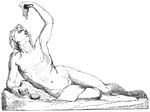
Greek Lekythos
This Greek Lekythos is made of red clay and painted in black. The form is elongated and cylindrical,…
Greek Lekythos
This Greek Lekythos is made of red clay and painted in black. The form is elongated and cylindrical,…

Greek Lekythos
This Greek Lekythos is made of red clay and painted in black. The form is elongated and cylindrical,…

Greek Lekythos
This Greek Lekythos is made of red clay and painted in black. The form is elongated and cylindrical,…

Greek Lekythos
This Greek Lekythos is made of red clay and painted in black. The form is elongated and cylindrical,…

Greek Lekythos
This Greek Lekythos is painted in black and white. The form is elongated and cylindrical, while the…

Greek Lekythos
This Greek Lekythos has an attic style. The form is elongated and cylindrical, while the neck is long…

Greek Lekythos
This Greek Lekythos has an attic style. The form is elongated and cylindrical, while the neck is long…

Greek Lekythos
This Greek Lekythos is made of red clay and painted in black. The form is elongated and cylindrical,…

Greek Lekythos
This Greek Lekythos is made of red clay and painted in black. The form is elongated and cylindrical,…

Greek Lekythos
This Greek Lekythos is made of red clay and painted in black. The form is elongated and cylindrical,…

Greek Lekythos
This Greek Lekythos is painted in black and white. The form is elongated and cylindrical, while the…

Greek Aryballos
This Greek Aryballos is a small spherical shape with a narrow neck. It is used as a perfume vase.
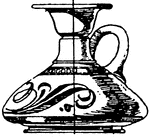
Greek Lekythos
This Greek Lekythos has an elongated and cylindrical form with a long neck. Its a type of Greek pottery…
![William Tyndale (sometimes spelled Tindall or Tyndall; (c. 1494 – 1536) was a 16th-century Protestant reformer and scholar who translated the Bible into the Early Modern English of his day. While a number of partial and complete Old English translations had been made from the seventh century onward, and Middle English translations particularly during the 14th century, Tyndale's was the first English translation to draw directly from Hebrew and Greek texts, and the first to take advantage of the new medium of print, which allowed for its wide distribution (it is worth mention that some scholars claim he made this translation from Latin[citation needed]). In 1535, Tyndale was arrested, jailed in the castle of Vilvoorde outside Brussels for over a year, tried for heresy and burnt at the stake.](https://etc.usf.edu/clipart/62000/62019/62019_w-tyndale_mth.gif)
William Tyndale
William Tyndale (sometimes spelled Tindall or Tyndall; (c. 1494 – 1536) was a 16th-century Protestant…
Exedra at the Street of Tombs in Assos
An exedra is a semicircular recess set into a building's facade. The exedra at the Street of Tombs in…

Trypanosoma
Trypanosoma are of the class kinetoplastida, a monophyletic group of unicellular parasitic protozoa.…

Trypanosoma
Trypanosoma are of the class kinetoplastida, a monophyletic group of unicellular parasitic protozoa.…
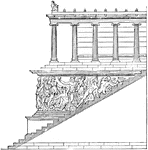
Frieze of Altar at Pergamon
The stairway of the great altar at Pergamon in Ancient Greece shows a frieze. A frieze is a sculpture…

Exterior of Walhalla
Walhalla, or German Temple of Fame and Honor is a neo-classical hall of fame located on the Danube River…

Glyptothek
The Glyptothek is a museum in Munich, Germany, which was commissioned by the Bavarian King Ludwig I…

Obverse and Reverse Sides of a Gazzetta
"Gazzetta of the Ionian islands, 1801. A small copper coin, worth about 3 farthings, made in Venice…
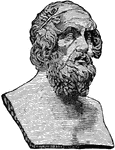
Bust of Homer
Homer is traditionally held to be the author of the ancient Greek epic poems the Iliad and the Odyssey,…

Profile Bust of Herodotus
Herodotus of Halicarnassus was a Greek historian who lived in the 5th century BC (c. 484 BC–c.…

Profile Bust of Thucydides
Thucydides was a Greek historian and author of the History of the Peloponnesian War, which recounts…

Sculpture of Demosthenes
Demosthenes was a prominent Greek statesman and orator of ancient Athens. His orations constitute a…
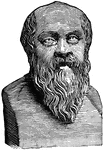
Bust of Socrates
Socrates was a Classical Greek philosopher. Credited as one of the founders of Western philosophy, he…
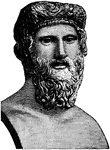
Bust of Plato
Plato was a Classical Greek philosopher, mathematician, writer of philosophical dialogues, and founder…

Statue of Aristotle
Aristotle was a Greek philosopher, a student of Plato and teacher of Alexander the Great. He wrote on…

Epicurus
Epicurus was an ancient Greek philosopher and the founder of the school of philosophy called Epicureanism.…
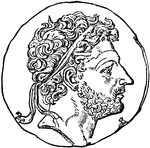
Perseus of Macedonia Coin
An illustration of a coin with the face of Perseus of Macedonia. Perseus the legendary founder of Mycenae…
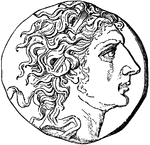
Mithradates VI Coin
An illustration of Mithradates VI on the face of a coin. Mithradates VI was king of Pontus in northern…

Athena
An archaic Athena on a vase from about 330 B.C. In Greek mythology, Athena was the goddess of wisdom.
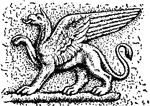
Griffin
"Griffin, from a Greek Sarcophagus. GRIFFIN. In mythology, an imaginary animal supposed to be generated…
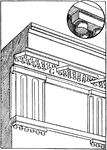
Gutta in Doric Architecture
"Guttae in Doric Architecture. A, form of gutta beneath regula; G, G, guttae beneath mutules and regulae.…

Engraved Greek Pitcher
Elaborate engravings decorate this elegant Greek pitcher. Women in traditional garb and horses are shown…

Vase
This vase with lid is an antique design, Greek or Roman. It was designed by famous potter Josiah Wedgwood.

Vase
This vase with handle has an antique design, Greek or Roman. It was designed by famous potter Josiah…
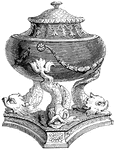
Vase
This vase is an antique design, Greek or Roman. Held on a pedestal of fish, it was richly designed by…

Vase
This vase is an antique design, Greek or Roman. It has two handles and a design of a figure in the center…

Large Vase
This large vase antique design, Greek or Roman. It was designed by famous potter Josiah Wedgwood.

Large Vase
This large vase antique design, Greek or Roman. It was designed by famous potter Josiah Wedgwood.

Large Vase
This large vase antique design, Greek or Roman. It was designed by famous potter Josiah Wedgwood.

Side-Board
This side-board is made out of mahogany, traditionally used in the dining room for serving food. It…

Crystal Jug
This crystal jug is called the "Neptune Jug", which shows a representation of the Greek god of the sea.
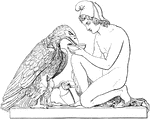
Sculpture
This sculpture depicts Ganymede feeding an eagle. Ganymede is a prince from Greek mythology.
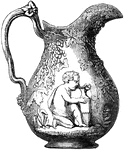
Jug
This jug has a design that depicts a young Bacchanal (Greek God of Wine) drinking the juice of the grape.

Statue of Narcissus
This statue of Narcissus a Greek Mythological hero who was renown for his beauty. In this statue, he…

Flag of Cyprus, 2009
Color flag of Cyprus. White with a copper-colored silhouette of the island (the name Cyprus is derived…

Flag of Cyprus, 2009
Black and white outline flag of Cyprus. White with a copper-colored silhouette of the island (the name…

Flag of Greece, 2009
Color flag of Greece. Nine equal horizontal stripes of blue alternating with white; there is a blue…

Flag of Greece, 2009
Black and white outline flag of Greece. Nine equal horizontal stripes of blue alternating with white;…
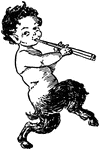
Pan
Pan in Greek religion and mythology, is the companion of the nymphs, god of shepherds and flocks, of…
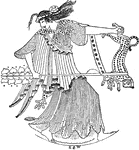
Maenads
In Greek mythology, Maenads were the female followers of Dionysus, the most significant members of the…




